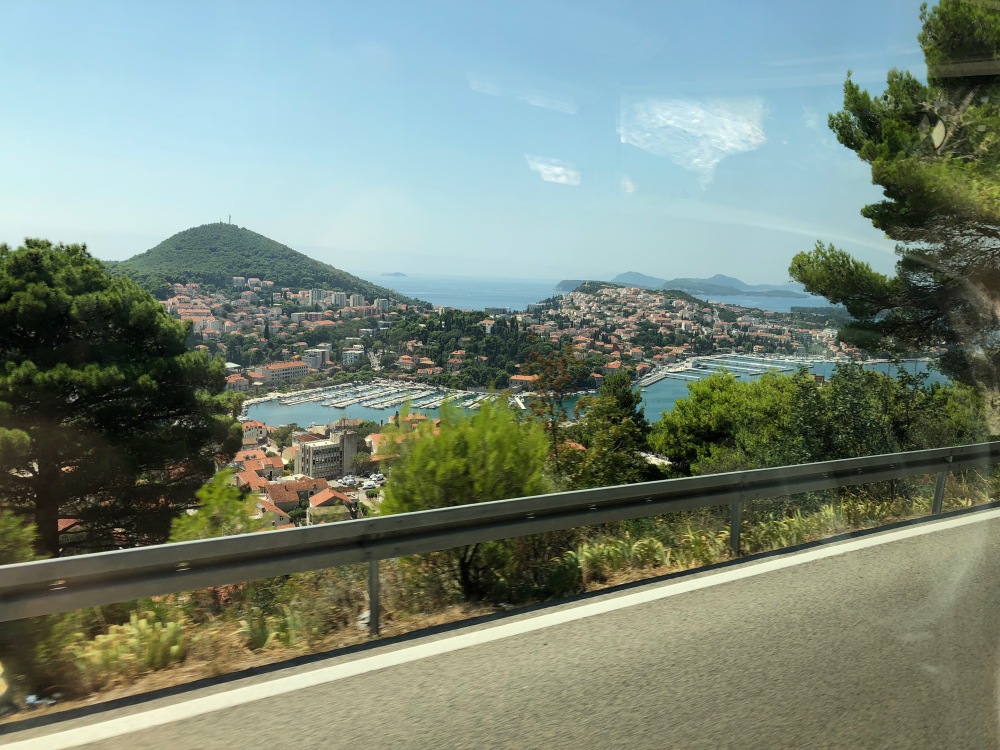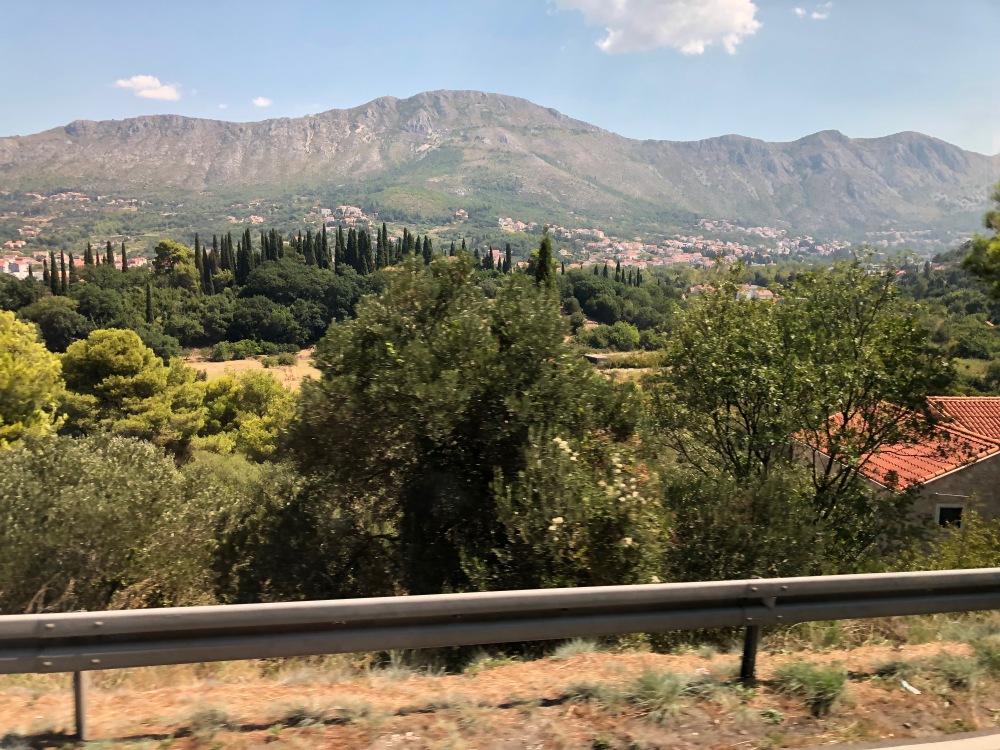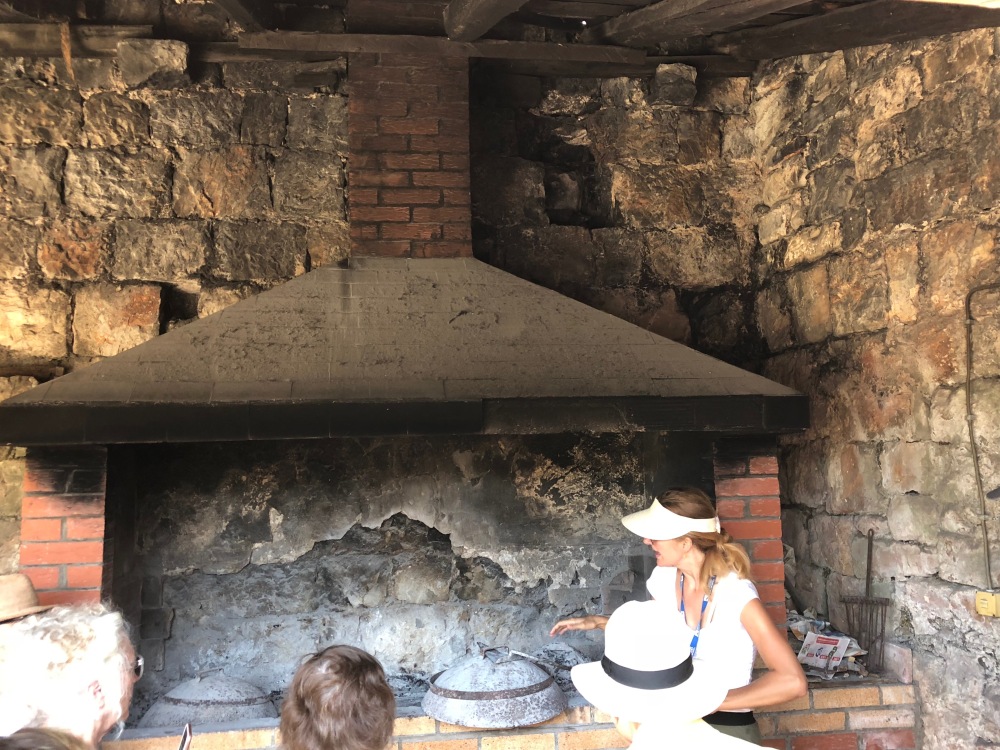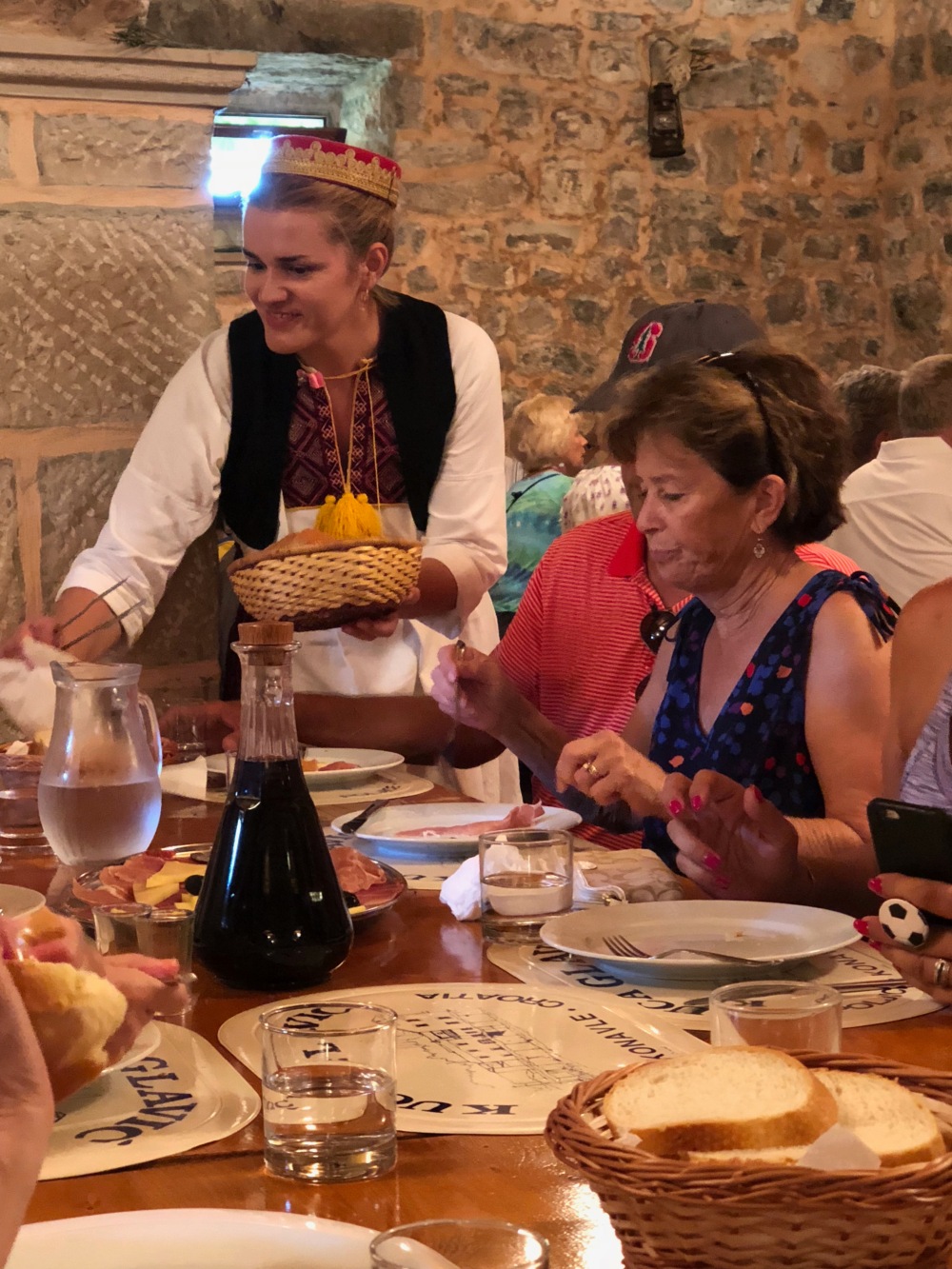“Those who seek paradise on earth,” George Barnard Shaw once wrote, “should come to Dubrovnik.” I totally agree. For today’s Thursday Doors, I am starting where we left off in my last post, outside the gates of the Old Town. I have some stories to add to this post as well……..are we going to travel by canoe to learn about them? No………….

Here is our tour guide for our visit in Dubrovnik and we’ll follow her wherever she goes. She is very energetic and enthusiastic and clearly loves her city. We are going to learn a lot from her!

As we entered Old Town (If you have not read my posts on Old Town, please do) she pointed out a sign that shows the damage done to Dubrovnik during the 1991 War with Yugoslavian forces, Montenegrin forces and Serbian para-military forces. The sign shows that the pink area were buildings burned down, the dark rectangles were homes damaged from shelling and the round circles show damaged streets from shelling. I will attempt a short report on what led up to these bombings.
In 1991, Slovenia, Croatia and Bosnia opted for secession and sought their independence from Yugoslavia. There had always been a fragile ethnic balance in the region and Yugoslavia took advantage of that and wanted to stop the countries from breaking away by promoting ethnic cleansing and bringing the fold back into the nation of Yugoslavia with distinct cultural lines. At that time in the region of Dubrovnik, there were 71,000 people. 50,000 lived in the city itself: The total represented 82 percent Croats, (Christians) 7 percent Serbs, and 4 percent Muslims. Dubrovnik, had been deemed a UNESCO World Heritage site in 1974 and there was no military presence there. The fortified Old Town consisted of high quality architectural buildings that had been preserved since the 1600’s and included many museums, and the libraries of the Franciscan and Dominican Monasteries and what some considered “the most important source for Mediterranean history, in the world.” When the fighting began the inhabitants of Dubrovnik did not believe that their city would be a military target. In the meantime, the Yugoslavs were also baiting Montenegro. They pointed out that this would be a good time for the Montenegrin forces to join the Yugoslavs and Serbs, to take Dubrovnik, and in return for their help Dubrovnik could become the capital of Montenegro. The general population of Montenegro was inundated with stories of Croatian interference and that the Croatians were planning an attack on Montenegro. The Montenegrin population was suspicious of these revelations and motives from their ruling government, and did not enlist when called up to service, until they were threatened with jail time. In late September, the Konavle Valley of Croatia, was overrun by hostile forces and 16,000 people fled to the Old Town of Dubrovnik, where they thought they would be safe. Following that, the communications tower above the city was bombed and all water and electricity turned off in Dubrovnik and the surrounding area. On October 1, 1991 shelling and mortar attack commenced on Dubrovnik, from ground troops, ships at sea, and the Yugoslav Air Force. Yugoslav forces also implemented a sea blockade of the entire area and occupied the Dubrovnik Airport. Yugoslavia insisted that only military installations were being targeted and that they were being attacked by the Croats from Dubrovnik.
International humanitarian organizations, such as UNICEF, were in communication with the Croatian National Forces and the Yugoslav, Serb, and Montenegrin forces, to assist in an evacuation of refugees from Dubrovnik by sea. This was made more difficult when the siege progressed, but negotiations were made and 7,000 refugees were evacuated by sea in late October and a further 9,000 people,( mostly pregnant women, mothers with small children , the elderly and sick) were able to leave by sea a few days later. This is where the story from our tour guide comes in. She was one of the small children evacuated with her mother and sisters. Her father was a doctor and he remained behind with the rest of the male population. Her mother was able to survive in part due to the money she had sewn in her small daughter’s diaper for safe keeping, knowing that everything of value would be taken from the adults. Our tour guide only remembers having a fat, full (dirty diaper?) that no one was in a hurry to change. They were not allowed back into Dubrovnik until 1992 and had not had any word of their remaining family in Konavle or Dubrovnik in all that time. In November, Dubrovnik received the largest of humanitarian aid since the beginning of the siege. A civilian fleet of vessels made a successful attempt to sustain the city. Serbs and Montenegrins plundered the surrounding areas- all the hotels and the airport were heavily looted and damaged. They took all the boats from the marina, stole all valuable artwork and furniture, took cattle and tore all the electrical wires from the houses. 1.5 billion euros of damage was done. Also, two prisoner-of-war camps were set up, one in Bileća and the other in Morinj. During the offensive 432 civilians from Konavle were imprisoned and subject to physical and psychological abuse. More than 400 soldiers from both sides were killed as well as 92 civilians in Dubrovnik. 2027 houses were completely destroyed and 7700 residents left homeless. In Old Town Dubrovnik, 824 buildings had been destroyed or struck by shells. 314 of the city’s baroque buildings and marble streets were direct hits. The price of reconstruction and repair was over 10 million US dollars. The city was rescued by Croatian Forces in 1992, but there were intermittent bombings, during the peace talks, up until 1995. Following the war, there was a Hague Tribunal and Serbian and Montenegrin officers were tried for destruction of Dubrovnik and targeting civilians during the war, especially for the killing of fireman as they tried to put out the fires. They were sentenced to 5-7 years in prison and after serving two-thirds of their sentence were released.

As I have already posted two posts on Old Town Dubrovnik so I won’t go into that any further. We are going to the Konavle Valley, where the fighting first took place in 1991 and also is the home and business of our guide’s grandmother. Grandmother lives at the family’s olive oil farm, which has operated from the late 1800’s and is run now by two of her sons. We have been invited to see the countryside and olive farm. The first photos are taken from the bus. I wanted you to see the roads and the scenery as we make our way to Grandmas.






The Konavle Valley is very fertile with lush olive groves and clusters of houses along the way. Over that mountain is Bosnia/Herzegovina, and there are still checkpoints at their borders with Croatia till this day. Along the way we learn about the Croatian culture. Many families still live all together like they have over the centuries and our guide points out a very big, well maintained home with over sixty family members, who continue the old ways and all live in one home. She and her husband live in their own home along the beautiful coast line we are following. But, the entire family of brothers and sisters and cousins and all, still meet and eat on Sundays with grandma.

When we arrive at grandmas…….

The farmhouse………..

the grapes………..

The multi-layered olive mill, press, wine cellar and farmhouse is a maze of doors, tunnels, and rooms. I bet you never thought I would get to the doors!

We were met by some of the cousins, who introduced us to grape brandy. Grape brandy, olive oil and wine are produced, the traditional way, at the farm. We learned all about the National dress of Croatia, the girls wearing the red caps are unmarried. Married women wear white kerchiefs.

There were multiple terraces and layers to the farmhouse, as you will see.

and they had everything displayed perfectly and were so hospitable……… don’t those red roof tiles look like rows of bread?



We are getting a demonstration of how the meat is barbecued every Sunday for all the family……..

in a very large oven space heated by wood……..

the ceiling was interesting too I thought……..

and we made our way through door after door which seemed like a maze to me……..


None of the old farm implements were taken during the war….and granny had buried all the wine……. There were many, many tools, and pots and old wooden utensils for everything. I won’t show all those photos, but I have them…..

Doors went to tunnels and cellars and nooks and crannies…….I was lost.

Up the stairs and down the steps………..


through doors that led to the outside……

and back…….

and a door to the family area, where we went to be entertained and to eat.

by two more cousins………

the tables were set…..they are used to feeding big families.

we had local cheese, smoked ham, homemade bread and plenty of wine!

And met grandma, who speaks very little English. She did show her hand embroidered dainties, with the aid of great-granddaughter to aid in translations. All the young people are taught English as their first language in school.

Time to leave yet through another door……….


We absolutely loved Dubrovnik and look forward to going back……..The citizens have taken great pride in re-storing their city and again welcomes tourists to this part of the world.
Have a great door week! Look here to see what others are doing for Norm’s Doors!
It’s easy to do Norm’s Doors. Photograph some doors and post them to Thursday Doors on Thursday!
PS All photos were taken on our IPhones this year……..we are traveling lighter!
Very nice presentation of this community, looks beautiful, and what a lucky Grandma that has her family on Sundays
LikeLiked by 1 person
We were thrilled with the cultural tours we were able to do!
LikeLiked by 1 person
Wow this sounds like my kind of tour. Anything that gets you into the local culture and customs is right up my alley.
Great post 🙂
LikeLiked by 1 person
Norm, this is my favorite kind of tour too.You learn so much when you interact with the local community.
LikeLiked by 1 person
Haha, what a great hiding place a diaper is:) Stunning coast line, and the farming done her is so interesting! Thank you for this beautiful and interesting post!
LikeLiked by 1 person
Those are some ancient spaces at the olive oil farm! What an experience!
LikeLike
It was a great experience!
LikeLiked by 1 person
I doubt I’ll get to that part of the world, so I have been especially enjoying your photographs and stories and histories of Croatia. The doors, indeed, are interesting, but I love all the old stone work. They speak very old history to me. I just wish I could reach through your pictures to feel them with my hands. Lovely.
LikeLike
Thank You! I loved the interaction with the entire group!
LikeLike
Oops! Wrong web site up there. I’m commenting from my garden blog, invitation to the garden. Oh, well.
LikeLike
Do you have a separate garden blog now?
LikeLike